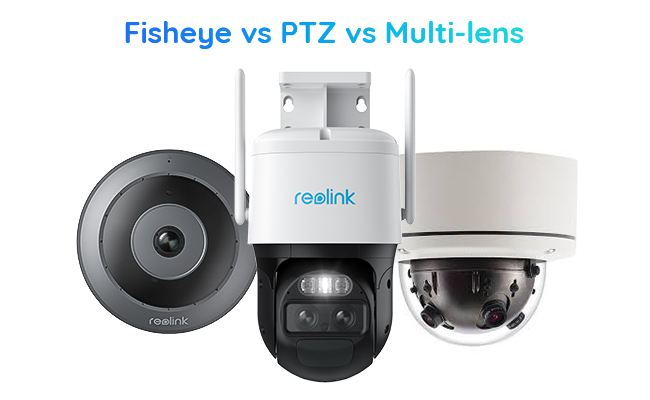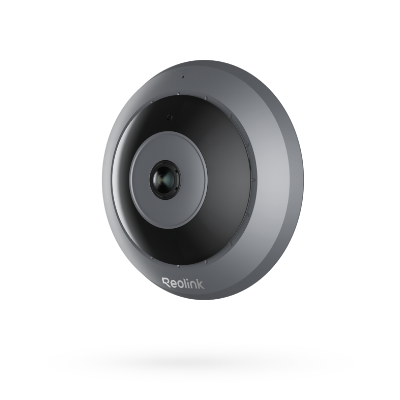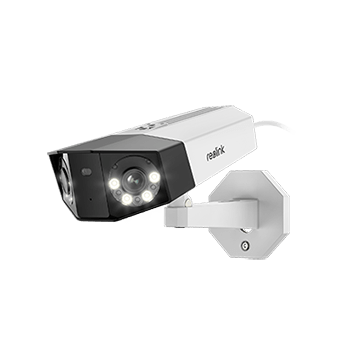Fisheye vs Multi-lens vs PTZ camera, Which's the Best?

For those searching for wide-angle home security cameras, choosing among a fisheye camera, multi-lens camera, and PTZ (pan-tilt-zoom) camera can be extremely hard. With each option featuring its unique set of strengths and weaknesses, it may take you some time to decide which one is really worth your money.
Don't worry. In this article we will review some key features of each of the above security camera types, which will help you know what security camera within your budget and sastisfy your surveillance needs.
What Are Fisheye, Multi-Lens, and PTZ Cameras?
There is a lot to talk about when making a comparison between fisheye cameras, multi-lens cameras, and PTZ cameras. But before we dive into their differences, it's necessary to understand what these three kinds of security cameras refer to as well as how they work.
Fisheye cameras
A fisheye camera is a type of security camera designed to provide a wide-angle view of the area being monitored. These cameras usually utilize one single lens with a very short focal length to cover an area with an extremely wide view angle, offering from 180 to 360 degrees field of view.
Fisheye cameras can be used for both indoor and outdoor surveillance applications, such as monitoring large areas like parking lots or stadiums.
Multi-lens cameras
Multi-lens cameras are also known as multi-sensor or panoramic cameras. They feature several lenses arranged in a particular pattern to allow for multiple angles of viewing simultaneously.
With a multi-lens security camera, several frames can be recorded at once from different angles for users to see all sides of an event or incident at the same time. Multi-lens cameras are often used in high-traffic areas where an intruder may appear from any direction.
PTZ (pan-tilt-zoom) cameras
PTZ (pan-tilt-zoom) cameras feature a motorized base that allows them to rotate up and down, left and right, as well as zoom in and out on the scene they’re monitoring.
This enables users to get a wide view and get to know what is happening without having to change the camera's position. PTZ cameras are especially useful for monitoring large and open areas and tracking suspects or intruders in real time.
Pros & Cons of Fisheye, Multi-Lens, and PTZ Cameras
One important common feature of these three kinds of security cameras is that they can provide you with up to 360° wide-angle view, which can reduce blind spots and also the cost of purchasing several cameras for monitoring a large area.
But the unique characteristics of each type of security camera determine their various applications in daily life. In this part, we're going to compare the major pros and cons of these different security cameras to help you decide which secyurity option would meet your needs.
Pros and cons of fish eyes cameras
Pros:
-
A whole 180° or 360° view: A fisheye security camera generally uses one lens to capture a whole 180-degree or 360-degree field of view.With one fisheye camera, you can have a comprehensive overview of activities happening in the area without having to adjust the camera's angle.
-
Discreet appearance: Due to the small size and enclosed lens, fisheye security cameras are more discreet than traditional CCTV cameras. Many of them have a round shape and sleek design, which make them less likely to be detected by intruders or passers-by, as they blend into their surroundings and are difficult to spot.
-
Reliable performance: Fisheye security cameras have their lenses protected in a robust and typically transparent shell. The shell provides additional protection for the lens and prevents external elements or attacks, making the camera reliable both indoors and outdoors.
Cons:
-
Image distortion: The image distortion is mainly caused by the extremely wide-angle lens. While providing a wide view, the lens results in strangely elongated or curbed objects in certain areas of the photo. Fortunately, some advanced fisheye security cameras adopt the de-warping technology and allow users to flatten the distorted images and have a better view.
-
Low resolution: Fisheye security cameras typically have lower resolution than other security cameras. Since they only have one lens and are primarily designed to capture a wide-angle view, their actual megapixels may be less than the rated megapixels. Also, the image quality will be further reduced when enlarging images or cropping them down to smaller sizes.
-
Limited installation possibilities: Installing a fisheye security camera can be limited because they are often mounted on walls, ceilings, and other flat surfaces. But you have to think carefully about which position can make the most out of the camera. The best place for a fisheye camera is the center of the room if you want to get a full 360° view, despite that the location always reveals the camera's presence.
Pros and cons of multi-lens cameras
Pros:
-
A seamless composite view: Multi-lens security cameras provide a seamless composite view made up of several images taken by each sensor from different angles. It gives the user a comprehensive overview and allows them to monitor activities in detail. Most importantly, the images captured by multi-lens security cameras are much less distorted than fisheye cameras.
-
High resolution & great image quality: Since each individual lens has its own image sensor, multiple lenses working together can produce sharper images with higher resolution than a single-lens camera. This improved image quality helps users view hard-to-see details more easily, enabling more accurate analysis and better identification of potential threats.
-
Various lens arrangements for different purposes: Multi-lens security cameras vary in terms of the number of lenses and their arrangement. Some multi-lens cameras have dual lenses while others have three or more lenses. Besides, the multiple lenses are not necessarily the same. Some manufacturers use different lenses, for example, a wide-angle lens and a telephoto lens, to satisfy users' needs of getting a wide view and identifying more details.
Cons:
-
Require advanced image stitching technology: Multi-lens security cameras require advanced image stitching technology in order to offer a composite overview from images captured by different lenses. The stitching technology is quite important as it determines whether the images you finally see are seamless or not. If not stitched well, the images can be deformed or distorted.
-
Increased risk of component failure: Due to multiple lenses and complex components, multi-lens security cameras have an increased risk of failing to work. Anything going wrong with one of those components in the system could lead to a breakdown in security monitoring capabilities. Such failures can also result in downtime and costly repair costs.
Pros and cons of PTZ security cameras
Pros:
-
Remote control: PTZ security cameras can be remotely operated. By using an app, users can adjust the viewing angle of the PTZ camera and have it capture footage of any desired area. Therefore, homeowners or business owners can see whatever they want without having to be physically present in the area.
-
Cruise function: Most PTZ security cameras allow users to pre-set several points and also patrol paths. In this way, the PTZ camera can move automatically according to the pre-set path even when no one is in control of the camera. This function offers a lot of conveniences when users want to see what's happening around their property.
-
Person/vehicle auto-tracking: The auto-tracking feature is another advantage offered by PTZ security cameras. The smart PTZ cameras can follow a person, a vehicle, or other objects as they move around the scene being monitored. Combined with motion detection, this feature can make it easier for owners to keep tabs on their property and keep track of any suspicious event.
Cons:
-
Latency sensitivity: When a user is controlling a PTZ security camera, there might be a delay between when they give the command and when the camera responds. This can lead to a frustrating and time-consuming experience, particularly if users are expecting an immediate response. Depending on the specific camera model, these delays can range from less than one second to multiple seconds.
-
Potential security breaches: Even though PTZ security cameras can provide a 360° view, the viewing angle of their lenses is often limited. When PTZ cameras move in various directions, it opens up loopholes for criminals and other malicious actors to take advantage of. For example, if the camera moves toward a preset direction, potential criminals may be able to hide from its view so that they can break into the property without detection.
-
High cost of purchasing and maintenance: Quality PTZ cameras are typically more expensive than other cameras as they offer a greater range of features and applications. Besides, the components enabling the camera to pan or tilt are always working, and thus they're more likely to break down. That's why PTZ security cameras require more maintenance and specialized knowledge to install and operate properly.
Which Is the Best?
It's hard to give a definite answer about which type of security camera is the best. It much depends on the specific needs of the environment being monitored.
Generally speaking, a PTZ camera is an ideal solution for large or open areas where users require remote control or zoom capabilities such as in parking lots, campuses, construction sites and warehouses.
A Fisheye camera usually offers 360° views and has a single lens that gives it its impressive field of view - perfect for applications with limited space such as retail businesses, lobbies, hotel corridors and atriums.
A multi-lens camera combines several distinct perspectives into a single device and offers remarkable coverage while consuming minimal bandwidth. Its optimal performance in both dark and bright light conditions makes it suitable for almost any application.
In terms of their price tags, PTZ cameras are a little more expensive than fisheye cameras and multi-lens cameras. But the price varies among different models of each type. Besides, you need to consider their functions and future maintenance.
Ultimately choosing between these three different types will largely depend on how you will use it – whether indoor/outdoor security monitoring, zoom functions, etc.
Recommendations of Fisheye, Multi-Lens, and PTZ Cameras
Choosing a quality security camera for your home or business can be difficult even if you've decided which type to look for. Here we've rounded up a list of the best security cameras that can suit your security needs. Save your time by directly selecting from the following products.
6MP HD panoramic fisheye camera - Reolink FE-W
The newly launched fisheye security camera by Reolink comes with quite a lot of fantastic features. It gives a whole 360° panoramic view and can cover every corner. Also, the 6MP super HD allows you to check every detail from crystal-clear images and videos.
6MP WiFi 360° Panoramic Indoor Fisheye Camera
6MP Super HD, 360° Panoramic View, 5/2.4 GHz Dual-Band WiFi, Multiple Display Modes, Smart Person Detection, Two-Way Audio, Clear Night Vision.
Reolink FE-W
6MP PoE 360° Panoramic Indoor Fisheye Camera
6MP Super HD, 360° Panoramic View, Power over Ethernet, Multiple Display Modes, Smart Person Detection, Two-Way Audio, Clear Night Vision.
There are PoE and WiFi versions of Reolink fisheye security cameras for your to choose FE-W. It has smart person detection and a built-in siren to deter intruders before they break in.
Also, Reolink adopts the de-warping mechanism and enables you to check flattened and natural images on Reolink App/Client.
4K dual-lens WiFi PTZ security camera - TrackMix WiFi
Reolink’s new TrackMix series combines multi-lens and PTZ technology in one device. The TrackMix WiFi is one of these models. It features a 4K wide-angle lens and a 1080p telephoto lens. The camera can pan and tilt to cover a wide area. Its auto-tracking feature lets it follow people and vehicles. Users can also zoom in for detailed close-ups.
4K Dual-Lens PTZ Camera with Motion Tracking
4K 8MP UHD, Wide-Angle & Telephoto Lenses, Pan-Tilt-Zoom, Auto-Tracking, Person/Vehicle Detection, 2.4/5 GHz Dual-Band WiFi, Two-Way Audio.
2K+ dual-lens security camera - Reolink Duo 2
Looking for a multi-lens security camera to monitor a large area? Try Reolink Duo 2!
Reolink Duo 2 is one of the best dual-lens security cameras on the market. It has twin lenses that capture images from different angles. With advanced stitching technology, you'll finally get a seamless 180° wide field of view.
Smart 4K Dual-Lens PoE Camera
4K 8MP Super HD, Dual-Lens, Person/Vehicle Detection, 180° Wide Viewing Angle, Power over Ethernet, Color & Infrared Night Vision.
Smart 2K+ Dual-Lens Battery Camera
6MP Super HD, Person/Vehicle Detection, 180° Wide Viewing Angle, Battery/Solar Powered, Dual-Band WiFi, Color Night Vision.
There are 4 versions of this dual-lens camera and each of them is packed with rich features including smart detection and color night vision. With so many features, Reolink Duo 2 series won't break the band and only cost around $200.
4K 360° PoE PTZ security camera - RLC-823A
If you prefer a PTZ security camera for outdoor monitoring, RLC-823A is a perfect choice because this security camera offers 4K 8MP ultra HD and provides a 360° view without distortion at all.
Smart PTZ PoE Camera with Spotlights
4K 8MP Ultra HD, Person/Vehicle Detection, 5X Optical Zoom, Auto Tracking, Manual Pan & Tilt, Two-Way Audio, 190ft Night Vision, Live View.
Smart PTZ PoE Camera with Spotlights
4K 8MP Ultra HD, Person/Vehicle Detection, 5X Optical Zoom, Auto Tracking, Manual Pan & Tilt, Two-Way Audio, 190ft Night Vision, Live View.
In addition to 360° pan and 90° tilt, RLC-823A has 5X optical zoom for you to zoom in or out and check details far away. Furthermore, this PTZ camera features smart person/vehicle/pet detection, which allows it to send you instant and accurate alerts.
With a motion-activated spotlight, RLC-823A can keep working both day and night and effectively deter any intruders.
Conclusion
Fisheye cameras, multi-lens cameras, and PTZ security cameras are widely used in our daily life. The most common feature of all these three types of cameras is the ability to cover large areas. After weighing their pros and cons, now you can make a reasonable decision. If you have any ideas or questions, don't hesitate to leave a comment below!
Search
Be in the Know
Security insights & offers right into your inbox




